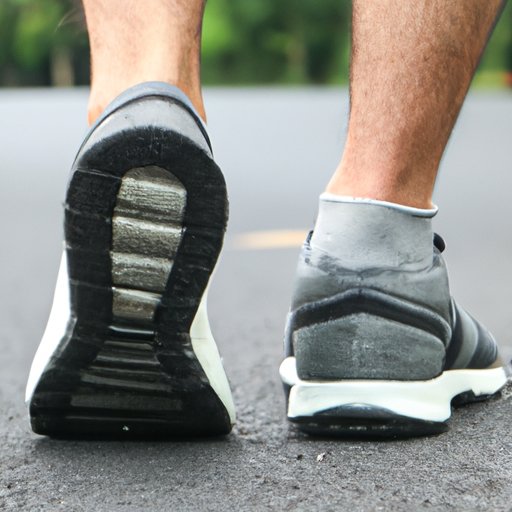
I. Introduction
Walking is a simple and accessible form of physical activity that has numerous health benefits. But can you lose weight walking? The answer is yes. In this article, we will explore the benefits of walking for weight loss, provide tips on how to start a walking routine, discuss studies that support the effectiveness of walking for weight loss, and offer a 30-day walking challenge to help jumpstart your weight loss journey.
II. Benefits of Walking for Weight Loss: How Simple Steps Can Help Shrink Your Waistline
Walking is a low-impact exercise that can be done anywhere, anytime, without any equipment. It is suitable for people of all ages and fitness levels. When it comes to weight loss, walking can help create a calorie deficit, which is essential for losing weight.
In addition to weight loss, walking has many health benefits, such as reducing the risk of chronic diseases like heart disease, diabetes, and certain types of cancer. Walking can also improve mood, reduce stress, and improve cognitive function.
Research has shown that, on average, a person can burn 100-300 calories by walking for 30 minutes, depending on their weight and walking pace. To lose one pound of body fat, a person needs to create a calorie deficit of about 3,500 calories. This means that if a person walks for 30 minutes every day for a week, they can burn roughly 1,500-2,100 calories, which is equivalent to half a pound to three-quarters of a pound of weight loss.
III. Steps to Success: A Comprehensive Guide on How to Lose Weight Walking
Before starting a walking routine for weight loss, it is essential to consult with a healthcare provider, especially if you have any medical conditions or physical limitations.
Once you get the green light to walk, it’s essential to set realistic goals and track your progress. Start by gradually increasing the time and intensity of your walks. Aim for at least 30 minutes of walking most days of the week. You can also break up your walking into shorter sessions throughout the day.
Make walking more enjoyable and effective by finding a walking partner, listening to music or audiobooks, varying your walking route, and incorporating other forms of physical activity, such as strength training and yoga.
IV. Shedding Pounds by Stepping Out: How Walking Can Help You Reach Your Ideal Body Weight
Walking can help you burn calories and lose weight, especially when combined with healthy eating habits. For example, a person who weighs 150 pounds can burn an average of 90-125 calories by walking for 30 minutes at a moderate pace of 3.5 miles per hour. If that person walks for 30 minutes every day for a week and consumes 500 fewer calories per day, he or she can lose one to two pounds per week.
Many people have successfully lost weight by walking. For example, Jessica, a 35-year-old mother of two, lost 50 pounds by walking 10,000 steps per day and following a healthy diet. Walking not only helped her lose weight but also improved her overall health and well-being.
V. Walking Your Way to a Trim Body: A Study on the Effect of Walking on Weight Loss
Several studies have examined the link between walking and weight loss. A meta-analysis of 33 studies found that walking is an effective way to reduce body weight, body mass index (BMI), and body fat percentage. The study also found that walking interventions of at least 150 minutes per week over a period of at least 12 weeks had the most significant effect on reducing body weight.
Another study found that walking reduces abdominal fat, which is associated with an increased risk of heart disease and diabetes. The study also found that walking for at least 30 minutes per day had a greater effect on reducing abdominal fat than diet alone.
While these studies provide evidence that walking can help with weight loss, more research is needed to determine the optimal walking duration, frequency, and intensity for weight loss.
VI. Lose the Belly, Keep the Feet Moving: Incorporating Walking as a Part of Your Weight Loss Plan
Walking can be incorporated into a weight loss plan along with other strategies, such as reducing calorie intake, drinking plenty of water, and getting enough sleep. Aim for a balanced diet that includes plenty of fruits and vegetables, lean protein, and healthy fats. Avoid or limit processed foods, sugary drinks, and alcohol.
Staying motivated can be a challenge, so find ways to make walking a habit. Set a schedule and stick to it, celebrate small wins, and reward yourself for meeting your goals. Make walking fun by exploring your local park, listening to your favorite music or podcasts, or joining a walking group.
VII. Walk off the Pounds: A 30-Day Challenge to Losing Weight Through Walking
If you’re ready to start a walking routine for weight loss, try our 30-day walking challenge. Each day, aim to walk for a certain amount of time or distance and gradually increase as the challenge goes on. You can modify the challenge to fit your fitness level and schedule. Don’t forget to track your progress and celebrate your achievements along the way.
VIII. Conclusion
Walking is an effective and accessible way to lose weight and improve your overall health. By setting realistic goals, tracking your progress, and making walking enjoyable, you can incorporate walking into your weight loss plan. Remember to consult with your healthcare provider before starting any exercise routine and stay motivated by celebrating your achievements.




